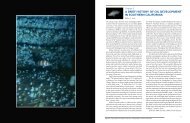checklist (pdf) - The Love Lab - University of California, Santa Barbara
checklist (pdf) - The Love Lab - University of California, Santa Barbara
checklist (pdf) - The Love Lab - University of California, Santa Barbara
Create successful ePaper yourself
Turn your PDF publications into a flip-book with our unique Google optimized e-Paper software.
Family Lobotidae — Tripletails<br />
Lobotes pacificus Gilbert, 1898. Pacific Tripletail. To 110 cm (43.3 in) TL (Carpenter in Carpenter 2003).<br />
Circumglobal; in western Pacific as far north as Japan (Hatooka in Nakabo 2002) and southern Kuril<br />
Islands (Savinykh 1998); in eastern Pacific from San Pedro Breakwater, southern <strong>California</strong> (Rounds<br />
and Feeney 1993) to Chimbote, Peru (Beltrán-León and Rios Herrara 2000). Bays, brackish estuaries,<br />
coastal freshwaters, and sometimes well out to sea around floating objects (Allen and Robertson 1994).<br />
Considered by some authors a junior synonym <strong>of</strong> Lobotes surinamensis (Bloch, 1790).<br />
Family Gerreidae — Mojarras<br />
Diapterus peruvianus (Cuvier, 1830). Peruvian Mojarra or Shortsnout Mojarra. To 38 cm (15.0 in) TL<br />
(Amezcua Linares 1996). Bahia Magdalena, southern Baja <strong>California</strong> (De La Cruz-Agüero et al. 1994)<br />
to Caleta La Cruz, Peru (Chirichigno and Vélez 1998), including lower and central Gulf <strong>of</strong> <strong>California</strong><br />
(Robertson and Allen 2002) and Islas Galápagos (Grove and Lavenberg 1997). Surface to 104 m (341 ft)<br />
(min.: Robertson and Allen 2002; max.: Amezcua Linares 1996); also in estuaries and lower parts <strong>of</strong><br />
streams (Allen and Robertson 1994).<br />
Eucinostomus currani Zahuranec, 1980. Blackspot Mojarra, Flagfin Mojarra, Pacific Flagfin Moharra, or<br />
Spotted-fin Mojarra. To at least 21 cm (8.3 in) TL (Robertson and Allen 2002). Anaheim Bay, southern<br />
<strong>California</strong> (Bussing in Fischer et al. 1995) to Huacho, Peru (Chirichigno and Vélez 1998), including<br />
Gulf <strong>of</strong> <strong>California</strong> (Bussing in Fischer et al. 1995), Islas Galápagos (Grove and Lavenberg 1997), and Isla<br />
Cocos (Robertson and Allen 2002). <strong>The</strong> Eucinostomus sp. <strong>of</strong> Miller and Lea (1972) refers to this species<br />
(Nelson et al. 2004). Intertidal area (SIO 71-51) and to 100 m (328 ft; Amezcua Linares 1996), and<br />
freshwater streams (Allen and Robertson 1994).<br />
Eucinostomus dowii (Gill, 1863). Dow’s Mojarra, Pacific Spotfin Mojarra, or Silver Mojarra. To 20 cm<br />
(7.9 in) TL (Amezcua Linares 1996). Camp Pendleton Harbor (SIO 76-191), southern <strong>California</strong> to<br />
Gulf <strong>of</strong> <strong>California</strong> (De La Cruz-Agüero et al. 1997) and to Peru (Allen and Robertson 1994). Shallow<br />
bays and estuaries; tidepools and to 114 m (3–374 ft) (min.: Thomson and Lehner 1976; max.: Amezcua<br />
Linares 1996). We follow Nelson et al. (2004) in treating Eucinostomus argenteum records from the<br />
Pacific Ocean as E. dowii.<br />
Eucinostomus entomelas Zahuranec, 1980. Blackgill Mojarra, Black-spot Mojarra, or Darkspot Mojarra. To<br />
24 cm (9.5 in) TL (Robertson and Allen 2002). From 4.8 km (3 mi) east <strong>of</strong> the entrance to Laguna Ojo<br />
de Liebre (27°54'N, 114°18'W), central Baja <strong>California</strong> (SIO 52-141) to northern Peru (Chirichigno and<br />
Vélez 1998), including southern and central Gulf <strong>of</strong> <strong>California</strong> (Robertson and Allen 2002). At depths<br />
<strong>of</strong> 0–100 m (328 ft) (min.: Robertson and Allen 2002; max.: Amezcua Linares 1996).<br />
Eucinostomus gracilis (Gill, 1862). Graceful Mojarra or Slender Mojarra. To 23.9 cm (9.4 in) TL (Amezcua<br />
Linares 1996). Bahia de Ballenas, southern Baja <strong>California</strong> (Zahuranec 1967) to northern Peru<br />
(Chirichigno and Vélez 1998), including southern Gulf <strong>of</strong> <strong>California</strong> (Bussing in Fischer et al. 1995)<br />
and Islas Galápagos (Grove and Lavenberg 1997). Mangrove estuaries (Allen and Robertson 1994) and<br />
coastal freshwaters (Bussing in Fischer et al. 1995); in ocean, surface and at depths <strong>of</strong> 1–112 m (3–367 ft)<br />
(min.: Gonzáles-Acosta et al. 1999; max.: Amezcua Linares 1996). Eucinostomus californiensis (Gill, 1862)<br />
and E. gracilis are synonymous. <strong>The</strong> name E. californiensis was selected as the correct name by Jordan<br />
and Evermann (1898) but this has been largely overlooked and E. gracilis is the name usually seen. <strong>The</strong><br />
current edition <strong>of</strong> the International Code <strong>of</strong> Zoological Nomenclature (ICZN 1999) allows continued use<br />
<strong>of</strong> the name E. gracilis, rather than introduce instability in nomenclature by not maintaining current<br />
usage.<br />
122




